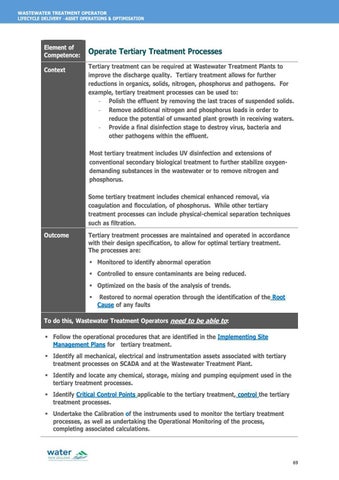WASTEWATER TREATMENT OPERATOR LIFECYCLE DELIVERY –ASSET OPERATIONS & OPTIMISATION
Element of Competence: Context
Operate Tertiary Treatment Processes Tertiary treatment can be required at Wastewater Treatment Plants to improve the discharge quality. Tertiary treatment allows for further reductions in organics, solids, nitrogen, phosphorus and pathogens. For example, tertiary treatment processes can be used to: - Polish the effluent by removing the last traces of suspended solids. - Remove additional nitrogen and phosphorus loads in order to reduce the potential of unwanted plant growth in receiving waters. - Provide a final disinfection stage to destroy virus, bacteria and other pathogens within the effluent. Most tertiary treatment includes UV disinfection and extensions of conventional secondary biological treatment to further stabilize oxygendemanding substances in the wastewater or to remove nitrogen and phosphorus. Some tertiary treatment includes chemical enhanced removal, via coagulation and flocculation, of phosphorus. While other tertiary treatment processes can include physical-chemical separation techniques such as filtration.
Outcome
Tertiary treatment processes are maintained and operated in accordance with their design specification, to allow for optimal tertiary treatment. The processes are: ▪ Monitored to identify abnormal operation ▪ Controlled to ensure contaminants are being reduced. ▪ Optimized on the basis of the analysis of trends. ▪
Restored to normal operation through the identification of the Root Cause of any faults
To do this, Wastewater Treatment Operators need to be able to: ▪ Follow the operational procedures that are identified in the Implementing Site Management Plans for tertiary treatment. ▪ Identify all mechanical, electrical and instrumentation assets associated with tertiary treatment processes on SCADA and at the Wastewater Treatment Plant. ▪ Identify and locate any chemical, storage, mixing and pumping equipment used in the tertiary treatment processes. ▪ Identify Critical Control Points applicable to the tertiary treatment, control the tertiary treatment processes. ▪ Undertake the Calibration of the instruments used to monitor the tertiary treatment processes, as well as undertaking the Operational Monitoring of the process, completing associated calculations.
69
